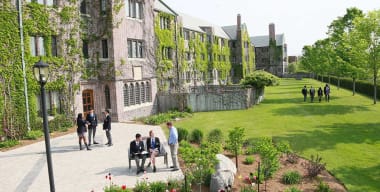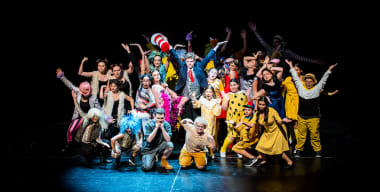Creativity is an eminently laudable human trait, but it is not something schools are suited to actively, consciously develop. Creativity is organic. In all likelihood, schools cannot ever hope to increase it, and their efforts to coax it out distracts from goals not attained elsewhere: chiefly, the ability to read and write well, along with myriad other abilities that must be learned, not guessed at or developed magically through free expression.
As a society we are conflicted about the meaning of creativity. Is "creativity" an artistic term? If so, does the art in question need to defy norms to be considered creative? (Would Michaelangelo's David be considered creative? Or merely the works of Henry Moore?) We hear media praise for a "creative solution" to a business or political dilemma, reducing "creative" to "clever." The language of creativity has been so devalued that we hear eccentric people popularly described as "creative types," especially if they have an unusual hairstyle and strange eyeglasses.

I am tempted to say that creativity, if it is to have much meaning at all, must fall somewhere in the area of this definition: a novel or innovative response, a new or original idea, or a satisfying artistic creation. This is the sort of definition we have in mind when we say schools should develop creativity in students. Put that way, who could oppose it, and on what grounds?
In fact, many have argued that modern schools' insistence on fostering creativity has been an unhelpful distraction. One of the most respected and widely read of these critics is Jacques Barzun, a French-born American cultural historian. As professor at Columbia University for 48 years, Barzun grew frustrated with an apparent decline in American academic ability. Since the 1960s, he has written widely on the issue of teaching and learning. (He is something of an outsider to the educational world, and refreshingly so.) He has opposed a range of what he considers educational fads on the basis that they confuse the mission of schools: namely and simply, to teach.
Barzun writes that many of the "nice" goals of modern schooling detract so thoroughly from what schools ought to do, and can do well, that we face something of a crisis. Self-esteem, ethics, physical fitness and the like can be gained outside the school; literacy cannot, nor can mathematics, nor an understanding of science, nor likely even history and literature. And it is hard to disagree with the idea that, for one reason or another, we do not have the educational system we desire. For all the billions of dollars spent, all the new "strategies" and all the hand-wringing, we are, by many indicators, a less literate and academically able society than we were a generation ago. But surely a school that focused on developing creativity in its students would witness increased student success.
Again, Barzun argues that time spent fostering creativity suffers from the problem inherent in many seemingly worthwhile goals of modern education: "It should have been obvious that self-expression is real only after the means to it have been acquired... the child is self-expressive when he painstakingly forms the letters a, b, c—though he is not able to 'create' a poem. Nor can creativeness be the object of his learning, since it is by definition unlearnable." 1 Barzun deftly points out the absurdity of thinking a school can teach innovation, imagination or creativity. And while many classrooms labour to dispense creativity, other more achievable lessons go untaught. The defender of teaching innovation will no doubt protest that the above unfairly characterizes what people mean when they clamour for creativity. Many will likely say this article misses the point entirely about imagination and innovation. They might even use the familiar jargon of education to confuse the issue by pointing out the many "strategies" and "approaches" that can be used fruitfully to encourage imagination in students, and they might even be able to point to educational research for support (that research in education is woefully unscientific rarely prevents its invocation). But, slippery terminology aside, what would it mean to promote creativity?
Barzun is almost certainly right to say that creativity cannot be taught. Probably, instead, well-meaning educationists intend that schools ought to somehow coax out creativity, or celebrate it when it does occur. Fine enough, but such an idea is too weak to form an educational program. Put simply: If creativity is a priority of schools and, as such, appears in a conscious way in the classroom, it is almost certainly bound to fail and, worse, will displace other more achievable goals; if instead it manifests itself informally, then it does not crowd out the central goals of a curriculum, but will be impotent to achieve the proponents' lofty goals. And the harsh truth stares us in the face: sadly, in many classrooms, "creative expression" is a term used to describe something that is the opposite of a hard-earned ability. "Very creative," is often polite code for something different altogether.
The foregoing might appear curmudgeonly, or even hostile. In many ways, it is. But as teachers, we need to question the comfortable assumptions of our craft. This is especially true as teachers in independent schools. These schools provide an interesting test case on the topic of fostering creativity, since the usual complaints about lack of resources are mostly moot. If creativity is going to be fostered anywhere, surely it will be in independent schools. However, even the most luxurious and well-appointed independent school suffers a scarcity: time.
Every moment spent on creativity, on placing the cart before the horse, is time not spent developing abilities that can be taught practically in a school. Creations that we regard as masterpieces were almost invariably made by those with a deep and studied training, those who worked hard and, yes, those who acquired some of their skills by rote. If, as literate, able teachers, we neglect the things schools can do (develop literacy, for example) in order to focus on things we probably cannot do (foster creativity), we impoverish our students.
If the reader is unconvinced, if we are still tempted to defend the wonders of unbridled innovation, let us end with a thought experiment. Imagine a bright-eyed student who takes a brush dippedin blue paint and smears it however she wishes over a piece of paper. Most of us would be pleased for her, for she derived enjoyment out of it. But, as her teacher, should we celebrate her creation as the layperson does? Or should we at least begin to instruct her on the proper way to hold the brush, on the rendering of shadows, and, when the time is right, even perspective? If we argue that her creativity would be stifled by a coercive and stultifying regimen of instruction, then we cannot complain when our students are not as able as we want them to be. As Barzun points out, "Unweeded soil undoubtedly grows wondrous things that nobody can predict. Such things we have in abundance, but it would be a rash man who would call it a harvest." 2
The idea of creative freedom is insidious if it deprives students, even in some small measure, of ability—be it the ability to read and write powerfully, to draw effectively or to understand mathematics—abilities that most teachers possess, but somehow in middle age regard as inferior to unskilled creative expression. Let us instead foster ability and leave creativity as it is: an innate, and eminently laudable, human quality.
1 Jacques Barzun, Begin Here: The Forgotten Conditions of Teaching and Learning, (Chicago:University of Chicago Press, 1991), p. 25.
2 Barzun, p. 27.









